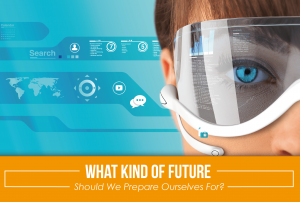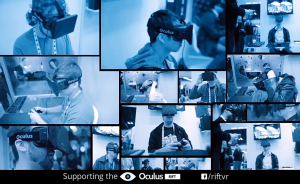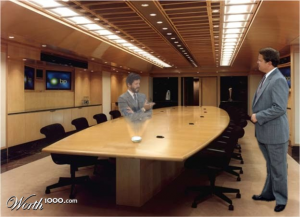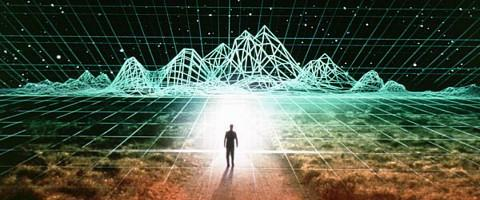5 Incredible Scenarios that Could Become Possible with the Upcoming Reality-Altering Devices
There are a number of “reality-changing” devices expected to launch within the next year – the Oculus Rift, Microsoft's HoloLens, Sony's Project Morpheus, Google Glass, and Magic Leap. We use the term “reality-changing” because although each of the aforementioned products can be classified as either virtual reality (VR), augmented reality (AR), or mixed reality (MR) devices, all of them can be accurately described under the umbrella term “reality-changing” because they all change your view of reality to varying degrees.
 We've already done a thorough comparison of the Oculus Rift, Microsoft's HoloLens, and Project Morpheus based on everything we know so far. Let's not forget there's also Samsung's Gear VR, but since that technology was developed by Oculus, it might as well be Samsung's version of the Rift.
We've already done a thorough comparison of the Oculus Rift, Microsoft's HoloLens, and Project Morpheus based on everything we know so far. Let's not forget there's also Samsung's Gear VR, but since that technology was developed by Oculus, it might as well be Samsung's version of the Rift.
Right now most of us are probably just looking at these devices as really neat gifts for the holidays and maybe a gateway to better gaming, but after researching the topic a doing a bit of imaginative thinking, you might be surprised to find that they could actually be opening the gateway to some very futuristic advancements in the 21st century.
Join us on this theoretical journey as we explore 5 amazing new possibilities and technological breakthroughs that could become possible in the near and far future through virtual, augmented, and mixed reality devices.
Cyber Travel: Exploring Expansive Open-World Environments, Including Replicas of Real Places
The big dream with virtual reality has always been to have the option to literally escape reality and jump into a true-to-life simulation of another realm, and what better way to experience a whole new dimension than to freely explore it at your own pace? Open-world games like Grand Theft Auto have always done well with consumers for the same reason – people have the instinctive urge to explore.
Fictional lands are always fun to become acquainted with in games, and developers have gotten pretty good at making fake landscapes, but there's nothing quite like remotely exploring an accurate replica of a place that actually exists. VR technology has the ability to scan and map entire areas and re-create 3D replicas for exploration.
Imagine visiting the luminescent bay in Puerto Rico, wandering around the edge of Niagara falls, scuba diving through the actual wreckage of the Titanic, walking on Mars, or exploring the Eiffel Tower. We're not talking about virtual places that look similar; we're talking actual 100% accurate replicas, so it would be almost as good as being there.
With VR technology humans will eventually be able to travel around the world and visit real places without ever leaving the comfort of their home. Within fifty years we'll probably see numerous efforts to map and re-create the most famous landmarks on Earth, and eventually there may even be a virtual backup of the entire planet.
The Beginning of the First “Time Machine”
This to me is perhaps the most interesting concept that comes to mind when I think of how reality-changing devices could impact society in the far future. How could virtual/augmented/mixed reality technology let us go back in time, you ask? The key is that they don't just change your view of reality, they also witness it first-hand, and therein lies the possibility for virtual time travel. I'll explain:
Imagine the world 1000 years from now. At that point reality-changing headsets will have been around for a Millennium. For many of those years the majority of the population will be wearing reality-changing devices (mostly mixed reality devices that can perform VR and AR functions) a significant portion of the time. The entire Earth will have been virtually mapped, and there will probably be a virtual version of the Earth available for VR exploration. This is where it gets interesting.
Virtual/augmented/mixed reality headsets will be equipped with highly advanced cameras and sensors, and could be programmed to continually record what the wearer is seeing while also collecting data in relation to the wearer's exact location and their surroundings. Right now people would be outraged by such an Orwellian state of surveillance, but 100-300 years from now it will most likely be common occurrence. What does all this have to do with time travel?
These devices will be capable of providing first-person views from the perspective of potentially billions of wearers across the span of hundreds or thousands of years. Let's say the world is under near-complete global surveillance by the year 2100. This means that between the cameras and sensors fitted into buildings, vehicles, headsets, and other wearables, most of the world could be continually recorded (especially in developed countries) and all of that data could be saved to the ever-growing digital cloud for later viewing at any point in history – essentially what the Wayback Machine is for the internet, but for the real world instead.
 Hypothetically, from that point on, humans would be able to “go back in time” and witness in virtual reality the events taking place in most places on Earth, from the first-person perspective of most people on Earth, or from the view of millions of surveillance devices (but in 3D, not 2D). This is all hypothetical and would of course require the government, establishments, and technology manufacturers working together in a collective effort to implement the necessary systems.
Hypothetically, from that point on, humans would be able to “go back in time” and witness in virtual reality the events taking place in most places on Earth, from the first-person perspective of most people on Earth, or from the view of millions of surveillance devices (but in 3D, not 2D). This is all hypothetical and would of course require the government, establishments, and technology manufacturers working together in a collective effort to implement the necessary systems.
For example, in the year 2985 it may be possible for the governing authorities to pull up the viewing history of a specific wearer who lived 500 years earlier (in 2385), thereby going back in time to experience the world as that person did in order to relive and analyze an important history-changing event. This type of “time machine” could be tremendously useful in solving crimes and figuring out where things went wrong in the event of mishaps and catastrophes.
So you say it isn't real time travel, it's just retrospective surveillance, right? Well, it may actually be as close as we'll ever want to get to real time travel, and here's why:
The only shortcoming with this type of virtual “time travel” is that you'd only be able to observe; you wouldn't actually be able do or change anything in the past because you wouldn't actually physically be there, even though you might literally feel as though you've gone back in time and are seeing the world in 3D through the perspective of the targeted headset wearer who lived hundreds of years earlier. A similar type of simulated surveillance-based time travel is depicted in the movie Source Code.
The fact that you wouldn't be able to change anything that happened is actually a good thing, because mathematically speaking, if you were to change even the smallest thing that happened hundreds of years in the past, there is a very high probability that you could cause yourself to never have existed and/or drastically change the course of history in millions of unforeseen ways, simply because you have no idea how your actions will affect the chain of events that led to your great-great-grandparents conceiving your grandparents, and so forth.
This phenomena is commonly referred to as the butterfly effect, originating from the example that a butterfly could flap it's wings on one side of the world and create a minuscule, yet very real effect on a weather pattern on the other side of the world. In other words, every single thing that happens is just one event in an ongoing chain, with each event occurring only because of past events that directly influenced the present. With all of that said, a study has already shown that it's possible to trick people into thinking that they actually went back in time using virtual reality. So apparently there is interest in this field already, and it looks like the makers of Source Code might have actually been on to something.
Simulated Teletransportation: Sitting In the Same Room With Someone Who Is On the Other Side of the World
At some point in the next 1-2 decades we might see people talking about today's cutting-edge video calling technology in this context:
“Prior to the advent of VR and virtual meetings, the most aesthetically advanced communication method available to the public was video calling, which displayed users' faces to each other in 2D video on a computer screen via a direct two-way audio/video feed. Luckily, we now have virtual/mixed/augmented reality devices that can practically insert people and items into your living room using data from specialized cameras and sensors.”
 Imagine putting your VR headset on and seeing your cousin who lives across the Atlantic, except he's not playing on a video inside of a screen, he's 3-dimensionally next to you, on your couch, or on his couch, or on an imaginary couch (in full VR), depending on the host-defined settings for that particular virtual meeting.
Imagine putting your VR headset on and seeing your cousin who lives across the Atlantic, except he's not playing on a video inside of a screen, he's 3-dimensionally next to you, on your couch, or on his couch, or on an imaginary couch (in full VR), depending on the host-defined settings for that particular virtual meeting.
Another cool concept - with object recognition and tracking technology, VR software could hypothetically be asked to include certain objects or people in the virtual meeting, essentially letting the user virtually teletransport an exact image of themselves into someone else's living room, along with the objects or people of their choice. Here's a simple example scenario illustrating some of the potential applications:
Two sisters would like to hold a virtual meeting with their mother during the holidays. They're currently having a holiday party so there's a group of people in the living room, in which they have their special VR webcam mounted. They don't want to evacuate the house to hold the virtual meeting (after all it is a new form of communication, so it should be more convenient than a telephone call), nor do they want their VR webcam to project the entire contents of their living room, and all of the guests within range of the sensors, into their mother's living room. Thankfully none of that's an issue because the VR cam would only project the intended participants of the meeting, and any items or people they've designated as invited objects, into the virtual space.
If the sisters would like to bring one of their new gift's with them on their virtual meeting, they could hold it in front of the VR webcam and wait for it to be recognized as an object, once that object is locked onto by the software, it will become a part of the virtual meeting. Hypothetically, the wearer could even tap on a person next to them who is not wearing a headset, and the object recognition software could isolate that person's figure and project it into the display shown to the mother as well, thereby letting the wearer take objects and people with them to their virtual meetings.
The possibilities are vast – you could have custom virtual conference rooms for business meetings, romantic restaurants ideal for long-distance relationship dates, or serene outdoor settings for virtual yoga classes, etc. Such scenarios would be more along the lines of full VR meetings. In mixed or augmented reality, the same type of “virtual teletransportation” would be possible, but in more subtle ways (like a slightly transparent holographic image of a person projected into your actual living room, rather than in a mutually agreed upon virtual realm).
It's also possible that each party could be shown their own virtual realm while still seeing each other in the same meeting (sounds confusing, I know). That could help in situations in which the two parties choose not to agree on the same virtual environment for the meeting. For example, one party could choose to see themselves and the other person inside a Starbucks, while the other party chooses to see themselves and the other party sitting in the food court at a shopping mall; the surrounding environments wouldn't necessarily affect the meeting as long as both parties could still see each other clearly.
Multi-player gaming and collaborating with other players online could become particularly interesting with the virtual teletransportation concept in mind. I think we can all agree that playing a game with someone in the same room with you can be a lot more fun than playing with someone who you can only hear through a headset.
A highly advanced version of a device like the upcoming HoloLens could project your gaming buddy next to you on your couch (or at least it will appear that way to you as long as you're wearing the headset). When something exciting happens in the game you'd actually be able to exchange glances with your teammate and feel that sense of companionship that comes with in-person multiplayer gaming. Given that genuine teletransportation of human beings might not even be possible, virtual teletransportation is probably the closest we'll get for a very long time.
People Masquerading Behind Virtual Avatars
Another interesting idea is that people could choose to project a customized character or modified version of themselves into the digital realm, thereby creating an actual avatar for themselves, except unlike our current forum avatars that we have online, the VR avatars would be much more than a picture next to a username – in the virtual realm they would be actual entities/characters, and in theory, you wouldn't be able to tell if someone was showing you their real self, or a chosen avatar, unless there were laws requiring a person to specify when they're appearing as an avatar.
Virtual avatars might seem like a side perk to gaming and social networking right now, but twenty years from now it could be big business and there could be a lot of people taking the role-playing category to a whole new level. People could wind up living alternate lifestyles, going to work and interacting in society as themselves, and going home to jump into the virtual realm as their avatar alter-ego. There are already a lot of gamers that do this without 3D VR, so imagine how much more common this will be when people can practically turn into someone else and escape into the virtual realm.
Eventually, the whole avatar/fabricated character thing could pose entirely new identity theft risks. For example, a hacker could impersonate a businessman and take his place at an important company virtual meeting in order to steal sensitive data. As companies become more comfortable holding virtual meetings and spoiled executives inevitably get used to using this type of attendance to get out of having to show up for conferences in person, there will be a risk that the security of such virtual meetings could be compromised. Then again, there's a good possibility that hacking could becoming practically impossible by that point, considering the rate of advancement in internet security and encryption technology.
Building, Designing, and Visiting Digitally Augmented Structures
Right now, when you walk into a place of business, a public library, a house, or any other structure, you can only interact with the things that are physically there in “reality,” and if you want new “things” to interact with then you would need to physically place new “things” in the building. Or if you want the building to look different on the inside or outside, you 'd need to physically renovate it. Adding physical devices, televisions, and aesthetic features to a building costs money. But what if it was possible to put virtual things inside buildings, or even to design and construct entirely digital structures that only appear in the virtual realm.
For example, you walk into a blank white building made of extremely cheap yet sturdy walls that are there to serve merely as a shell. There are plain white props scattered here and there in the shape of common items like a desk, couch, countertop, etc. but other than that the place looks like an empty white room... until you put your goggles on and it transforms into a fully decorated establishment complete with HD displays on the wall, virtual kiosks, and even virtual employees.
These virtual employees could be holographic human-like robots that are programmed to provide customer service, or they could be the virtual representations of real people who are actually sitting at their house working an at-home job as a virtual receptionist for this purely virtual establishment. You could purchase merchandise or food items that would (in reality) be dispensed from machines that come out of the wall, but from your view (with the MR goggles on) it could look like someone was handing you the item, or the designer could choose to stick with less personal vending machine approach.
On any given day the design and functionality of a digital building could be renovated with a simple software update and a few prop/dispenser rearrangements. This type of digital design freedom could be a few decades away though, as it currently costs $1 million to produce just 3 minutes of content in VR.
This might all sound like futuristic mumbo jumbo, but when investors and entrepreneurs start to see the money-saving benefits of founding entirely digital establishments built inside of blank low-cost structures, there's a very good chance we'll see this type of “physical cyberspace” development within the 21st century. We're sure the home decorating industry will have a lot of fun creating virtual accessories and decorations for the home. Although it could take decades before all of this becomes mainstream, it certainly seems like the next step in logical progression.
Imagine being able to change the entire appearance of your home just by changing the settings on your home design MR beacon, which would broadcast to all of the MR devices in your home exactly what everything in the house is supposed to look like, so the home would look the same to everyone wearing goggles. The best example we could find for this type of “enhanced reality through cyber objects” would be the trailer for Microsoft's HoloLens. You can see in the video below that the user is outfitting their environment with virtual objects, which they can then interact and work with, thereby bringing cyberspace into the physical realm:

